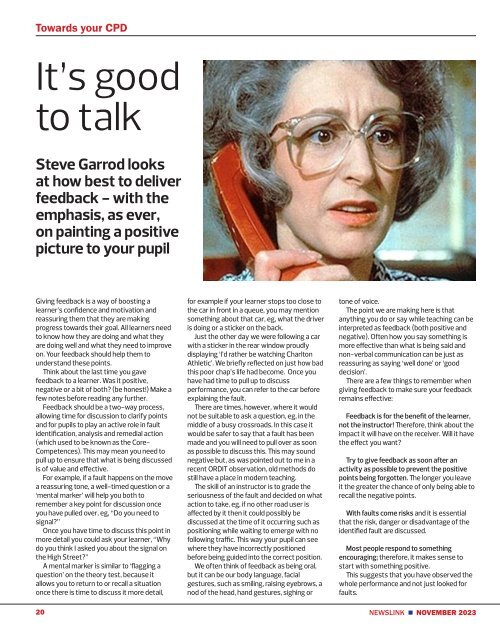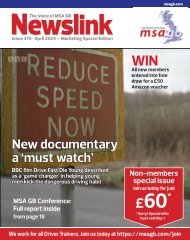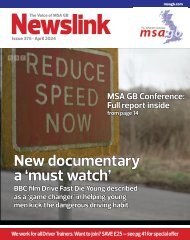Newslink November
Motor Schools Association of Great Britain members magazine; driver training and testing; road safety; general motoring
Motor Schools Association of Great Britain members magazine; driver training and testing; road safety; general motoring
Create successful ePaper yourself
Turn your PDF publications into a flip-book with our unique Google optimized e-Paper software.
Towards your CPD<br />
It’s good<br />
to talk<br />
Steve Garrod looks<br />
at how best to deliver<br />
feedback - with the<br />
emphasis, as ever,<br />
on painting a positive<br />
picture to your pupil<br />
Giving feedback is a way of boosting a<br />
learner’s confidence and motivation and<br />
reassuring them that they are making<br />
progress towards their goal. All learners need<br />
to know how they are doing and what they<br />
are doing well and what they need to improve<br />
on. Your feedback should help them to<br />
understand these points.<br />
Think about the last time you gave<br />
feedback to a learner. Was it positive,<br />
negative or a bit of both? (be honest!) Make a<br />
few notes before reading any further.<br />
Feedback should be a two-way process,<br />
allowing time for discussion to clarify points<br />
and for pupils to play an active role in fault<br />
identification, analysis and remedial action<br />
(which used to be known as the Core-<br />
Competences). This may mean you need to<br />
pull up to ensure that what is being discussed<br />
is of value and effective.<br />
For example, if a fault happens on the move<br />
a reassuring tone, a well-timed question or a<br />
‘mental marker’ will help you both to<br />
remember a key point for discussion once<br />
you have pulled over, eg, “Do you need to<br />
signal?”<br />
Once you have time to discuss this point in<br />
more detail you could ask your learner, “Why<br />
do you think I asked you about the signal on<br />
the High Street?”<br />
A mental marker is similar to ‘flagging a<br />
question’ on the theory test, because it<br />
allows you to return to or recall a situation<br />
once there is time to discuss it more detail,<br />
for example if your learner stops too close to<br />
the car in front in a queue, you may mention<br />
something about that car, eg, what the driver<br />
is doing or a sticker on the back.<br />
Just the other day we were following a car<br />
with a sticker in the rear window proudly<br />
displaying ‘I’d rather be watching Charlton<br />
Athletic’. We briefly reflected on just how bad<br />
this poor chap’s life had become. Once you<br />
have had time to pull up to discuss<br />
performance, you can refer to the car before<br />
explaining the fault.<br />
There are times, however, where it would<br />
not be suitable to ask a question, eg, in the<br />
middle of a busy crossroads. In this case it<br />
would be safer to say that a fault has been<br />
made and you will need to pull over as soon<br />
as possible to discuss this. This may sound<br />
negative but, as was pointed out to me in a<br />
recent ORDIT observation, old methods do<br />
still have a place in modern teaching.<br />
The skill of an instructor is to grade the<br />
seriousness of the fault and decided on what<br />
action to take, eg, if no other road user is<br />
affected by it then it could possibly be<br />
discussed at the time of it occurring such as<br />
positioning while waiting to emerge with no<br />
following traffic. This way your pupil can see<br />
where they have incorrectly positioned<br />
before being guided into the correct position.<br />
We often think of feedback as being oral,<br />
but it can be our body language, facial<br />
gestures, such as smiling, raising eyebrows, a<br />
nod of the head, hand gestures, sighing or<br />
tone of voice.<br />
The point we are making here is that<br />
anything you do or say while teaching can be<br />
interpreted as feedback (both positive and<br />
negative). Often how you say something is<br />
more effective than what is being said and<br />
non-verbal communication can be just as<br />
reassuring as saying ‘well done’ or ‘good<br />
decision’.<br />
There are a few things to remember when<br />
giving feedback to make sure your feedback<br />
remains effective:<br />
Feedback is for the benefit of the learner,<br />
not the instructor! Therefore, think about the<br />
impact it will have on the receiver. Will it have<br />
the effect you want?<br />
Try to give feedback as soon after an<br />
activity as possible to prevent the positive<br />
points being forgotten. The longer you leave<br />
it the greater the chance of only being able to<br />
recall the negative points.<br />
With faults come risks and it is essential<br />
that the risk, danger or disadvantage of the<br />
identified fault are discussed.<br />
Most people respond to something<br />
encouraging; therefore, it makes sense to<br />
start with something positive.<br />
This suggests that you have observed the<br />
whole performance and not just looked for<br />
faults.<br />
20 NEWSLINK n NOVEMBER 2023
















